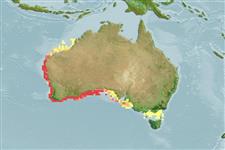Common names from other countries
>
Eupercaria/misc (Various families in series Eupercaria) >
Labridae (Wrasses) > Corinae
Etymology: Coris: Greek, kore, -es = pupil and also with themenaing of "maid" (Ref. 45335).
More on author: Valenciennes.
Environment: milieu / climate zone / depth range / distribution range
Écologie
marin récifal; profondeur 1 - 45 m (Ref. 33411). Subtropical
Eastern Indian Ocean: Australia.
Taille / Poids / Âge
Maturity: Lm ? range ? - ? cm
Max length : 40.0 cm TL mâle / non sexé; (Ref. 9710)
Épines dorsales (Total) : 9; Rayons mous dorsaux (Total) : 12; Épines anales: 3; Rayons mous anaux: 12. Corner of mouth without canine; second teeth in jaws about 1/2 length of anterior canines in adults, about 3/4 in subadults.
Inhabits shallow rocky and coral reefs with sand patches. Juveniles and females act as cleaners (Ref. 9710).
Life cycle and mating behavior
Maturities | Reproduction | Spawnings | Egg(s) | Fecundities | Larves
Oviparous, with distinct pairing during breeding (Ref. 205).
Randall, J.E., 1999. Revision of the Indo-Pacific labrid fishes of the genus Coris, with descriptions of five new species. Indo-Pac. Fish. (29):74 p. (Ref. 33411)
Statut dans la liste rouge de l'IUCN (Ref. 130435)
CITES (Ref. 128078)
Not Evaluated
Menace pour l'homme
Harmless
Utilisations par l'homme
Outils
Articles particuliers
Télécharger en XML
Sources Internet
Estimates based on models
Preferred temperature (Ref.
115969): 17.5 - 24, mean 18.4 (based on 62 cells).
Phylogenetic diversity index (Ref.
82804): PD
50 = 0.5000 [Uniqueness, from 0.5 = low to 2.0 = high].
Bayesian length-weight: a=0.00977 (0.00470 - 0.02030), b=3.07 (2.89 - 3.25), in cm Total Length, based on LWR estimates for this (Sub)family-body shape (Ref.
93245).
Niveau trophique (Ref.
69278): 3.5 ±0.3 se; based on size and trophs of closest relatives
Résilience (Ref.
120179): Milieu, temps minimum de doublement de population : 1,4 à 4,4 années (Preliminary K or Fecundity.).
Fishing Vulnerability (Ref.
59153): Low to moderate vulnerability (30 of 100).
